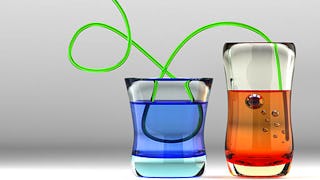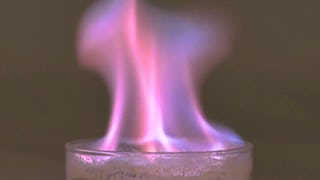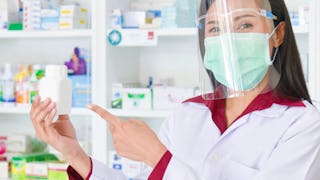Master essential chemistry principles that form the foundation of pharmacology, metabolism, and medical diagnostics. This course bridges basic chemical concepts with real-world healthcare applications, preparing you for advanced nursing coursework and clinical practice. Build confident understanding of molecular interactions, drug mechanisms, and laboratory interpretations essential for safe patient care.


Chemistry
包含在 中
您将学到什么
Analyze atomic structure, bonding theories, and molecular interactions to understand drug-receptor mechanisms
Evaluate acid-base equilibria, buffer systems, and redox reactions in biological and pharmaceutical contexts
Apply pharmacokinetic and pharmacodynamic concepts to understand drug action, enzyme interactions, and antibiotic mechanisms
Explain organic chemistry principles including functional groups, stereochemistry, and reaction mechanisms relevant to biomolecules
要了解的详细信息
了解顶级公司的员工如何掌握热门技能

积累 Basic Science 领域的专业知识
- 向行业专家学习新概念
- 获得对主题或工具的基础理解
- 通过实践项目培养工作相关技能
- 通过 Lecturio 获得可共享的职业证书

该课程共有4个模块
Chemistry is the scientific study of the properties of matter. It is a natural science that involves the elements that make up matter—their compositions, structures, properties, and behaviors, as well as the changes they undergo when reacting with other substances. At its most basic level, chemistry helps to explain how molecules and atoms may interact via chemical bonds and form new chemical compounds. In the body, this can be applied to our fundamental building blocks—for example, explaining why DNA behaves the way it does, how proteins fold, and why cell membranes have hydrophilic and hydrophobic compartments. Clinically, we encounter chemistry most often as it applies to pharmaceuticals and pharmacology. It governs the behavior of these molecules in our bodies, as with regard to bioavailability to binding sites and other characteristics.
涵盖的内容
28个视频5篇阅读材料28个作业
Ionic chemistry is the field of chemistry that focuses on ions and ionic bonds, including the concepts of acid–base reactions, oxidizing and reducing agents, buffer capacity, and equilibrium. Ionic bonding is the complete transfer of valence electrons between atoms. This type of chemical bond generates ions of opposite charges. In ionic bonds, the nonmetal becomes a negatively charged anion via acceptance of electrons, while the metal loses those electrons to become a positively charged cation. These concepts are extremely important for understanding basic physiologic functions, pharmacologic mechanisms, and the interplay between the two in the body. Buffers, for example, are regulators of pH in the bloodstream, while acid–base chemistry is key to understanding respiratory physiology. A strong grasp of ionic chemistry will serve you well in the field of medicine.
涵盖的内容
15个视频2篇阅读材料15个作业
You may notice that the Medical Chemistry section contains an inordinately large number of videos. This is no accident. The fields of medicine and chemistry are very closely linked, as the principles of the latter, in some way or another, touch nearly every aspect of the former (e.g., pharmacokinetics, bioavailability, the mechanisms of antibiotic resistance, and the basic building blocks of proteins and amino acids and how they interact with one another). Being able to grasp the chemical interplay between the human body and its environment is important not only for researchers and drug developers but also for clinicians.
涵盖的内容
32个视频6篇阅读材料33个作业
Organic chemistry is the study of the structures, properties, compositions, reactions, and preparations of carbon-containing compounds. Most organic compounds contain carbon and hydrogen, the backbones of organic chemistry, but often these compounds include any number of other elements, such as nitrogen, oxygen, phosphorus, and sulfur. Organic compounds are found in many modern materials, including but not limited to agrochemicals, food, fuel, cosmetics, pharmaceuticals, and plastics. They have been an important factor in economic growth and have proven foundational to fields like medicine, biotechnology, and biochemistry.
涵盖的内容
36个视频6篇阅读材料37个作业
获得职业证书
将此证书添加到您的 LinkedIn 个人资料、简历或履历中。在社交媒体和绩效考核中分享。
位教师

提供方
从 Basic Science 浏览更多内容
 状态:预览
状态:预览Duke University
 状态:预览
状态:预览Duke University
 状态:免费试用
状态:免费试用MedCerts
 状态:免费试用
状态:免费试用MedCerts
人们为什么选择 Coursera 来帮助自己实现职业发展




常见问题
To access the course materials, assignments and to earn a Certificate, you will need to purchase the Certificate experience when you enroll in a course. You can try a Free Trial instead, or apply for Financial Aid. The course may offer 'Full Course, No Certificate' instead. This option lets you see all course materials, submit required assessments, and get a final grade. This also means that you will not be able to purchase a Certificate experience.
When you enroll in the course, you get access to all of the courses in the Certificate, and you earn a certificate when you complete the work. Your electronic Certificate will be added to your Accomplishments page - from there, you can print your Certificate or add it to your LinkedIn profile.
更多问题
提供助学金,
¹ 本课程的部分作业采用 AI 评分。对于这些作业,将根据 Coursera 隐私声明使用您的数据。




